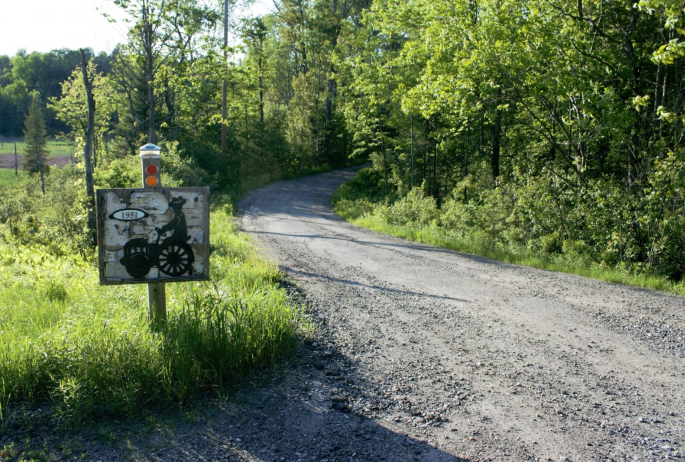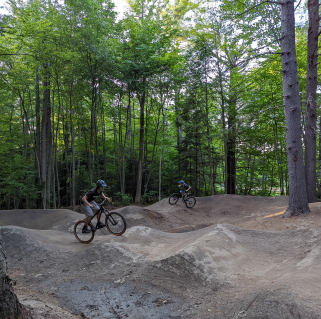Submitted by guest writer: Tyler Merriam
On a late Friday afternoon, I loaded my mountain bike in the back of my car and drove the short distance to the southernmost entrance of the Bloomingdale Bog Trail. For those of you who don’t know, this trail begins just off Route 86, about 3 miles north of the heart of Saranac Lake, and ends approximately 16 miles away in the town of Onchiota. The trail consists of well-packed sand and gravel with a few sections of roots and beaver-created puddles. It is a popular area for walkers and bikers in the snowless months, and cross-country skiers and snowshoers in the winter. You might say the Bloomingdale Bog Trail was a rail-trail before such ideas were popular, as it follows an old railroad right-of-way.

A right-of-way is a certain type of easement usually granted for transportation purposes, such as a highway, electrical transmission line, or railroad track. This particular railroad right-of-way once connected Saranac Lake to Plattsburgh on the now-defunct Chateaugay Division of the Delaware Hudson Railroad. Though it was abandoned in 1962, this division was once a centerpiece of industry for the northern Adirondacks. The Delaware Hudson Railroad is the country’s oldest surviving transportation company, though it is now part of Canadian Pacific Railroad, having been sold to them in 1991. The Chateaugay Division was first built in 1879 to move iron ore and charcoal from Lyon Mountain to Dannemora, and was later extended to Loon Lake in 1885, and Saranac Lake in 1887. As the Delaware Hudson Railroad experienced financial troubles in the mid-1900s, this section of railroad was eventually abandoned and later converted into a rail-trail.

As I removed my bike from the hatchback of my Subaru and adjusted the seat for flat terrain rather than my usual up-and-downhill riding, I was pleasantly surprised at the lack of insects in the parking lot. One of the reasons I chose to bike rather than hike, besides the ability to see more in less time, was to outrun the pesky insects that often bother in the spring months. It will forever perplex me how some areas have fewer bugs and others have more, and that bug density seems to vary based on location, time of day, time of month, and weather patterns. Soon after I left the parking lot I was quickly reminded that mosquitoes, an essential player in the ecological food chain, were still alive and well the moment I stopped peddling and laid my bike down to capture some photos of one my favorite wildflower, the Lupine. Thankfully the bugs didn’t bother too much as I knelt to view these purple symbols of the wildflower season, and I was soon back on my bike scouting for the next patch of wildflower and other bog vegetation.

I was not disappointed, for as soon as the trees cleared, and the wide-open bog came into view, I was greeted by a sea of white created by the lush patches of cotton sedge. This vegetation, also known as cotton grass, is a common sedge found in both lowland bogs and alpine environments of the Adirondacks. When cotton grass grows in thick clusters it appears as though the bog has been dusted with a fine layer of snow, as if you’re viewing the first snowfall of an early October morning. It’s a magical sight, and one found in few other areas of the park. I took a moment to snap a few photos and soak in the view before I climbed back on my bike and took off for the next viewpoint.

Biking through the Bloomingdale Bog is a unique experience, as you feel as if you’re on a narrow island amidst water channels and plant vegetation surrounding you. A bog is defined as a wetland formed by glacial melting with little surface drainage. They’re characterized by low oxygen, PH, and water temperature, all of which create slow decomposition that results in the buildup of fibrous peat moss. Only specialized plants can grow on bogs, the most well-known being pitcher plants, orchids, and sphagnum moss. The Bloomingdale Bog itself is one of the largest in the Adirondacks, and you’ll notice the amount of water just below the surface the minute you step off the trail. Thankfully the views are such that you need not leave the firm path to enjoy the splendor. This became even more apparent when I crossed the first open water of the trip, Twobridge Brook, that flows through the heart of this wetland. This brook is navigable in higher water, though you’ll get up close and personal with a lot of alder if you choose to make the journey. The rewards are worth it, though, as I’ve seen snapping turtles laying eggs on the shoreline, hooded mergansers still with their mates, and even the yellow spotted salamander walking along the shoreline of this rarely-paddled stream.

The views open on the bridge over Twobridge Brook, but they’re even better at the next waterway, which I reached soon after biking over Bloomingdale-Gabriels. Here I was greeted by a beautiful vista of Whiteface Mountain and the surrounding peaks. In the right light I imagine you’d be able to see the shining glint off the summit observatory as the sun reached the horizon line. Were it not getting dark I would have loved to stand at that brook crossing and watch the sunset cast its orange, red, and yellow glow on the shoulder of this majestic peak, a centerpiece of the surrounding community. But alas, the evening was drawing close, and I wanted to bike a little farther before I turned around.

Another enjoyable aspect of the Bloomingdale Bog Trail is the diversity of landscape throughout. One minute you’re surrounded by white pines and the trail is blanketed by the long, brown needles of these giants of the forest. The next minute you’re walled in by balsam fir and red spruce, creating a corridor isolating you from the landscape beyond. Neither of these natural handrails last long, however, and soon you’re once again in an open bog, complete with white-fringed orchis, bog laurel, Labrador tea, and tamarack dotting the landscape.

I turned around at the next landmark, Bigelow Road, a dirt road off Oregon Planes that is often thought of by locals as simply “the road with the bridge out.” Here blueberry bushes grow in abundance, a reminder to return later in the summer for a classic Adirondack treat. On the bike ride back to my car the many songbirds that frequent this area sang tunes as if bidding farewell to my afternoon journey. An amateur birder myself, I was at least able to pick out the call of the veery, white-throated sparrow, ovenbird, red-breasted nuthatch, chipping sparrow, black-capped chickadee, and the distant hammering of a woodpecker (I’m not yet astute enough to recognize a woodpecker by its drumming).

The bird calls, cool evening temperatures, warm glow of the setting sun, and solitude afforded by this trail reminded me of how lucky I am to live up here and have such therapeutic outlets mere minutes from my home. Whether by bike or by foot, the Boomingdale Bog Trail offers a little something for everyone, regardless of your recreational preferences in the natural world.
After a day of hiking or cycling, relax and dine in Saranac Lake.































